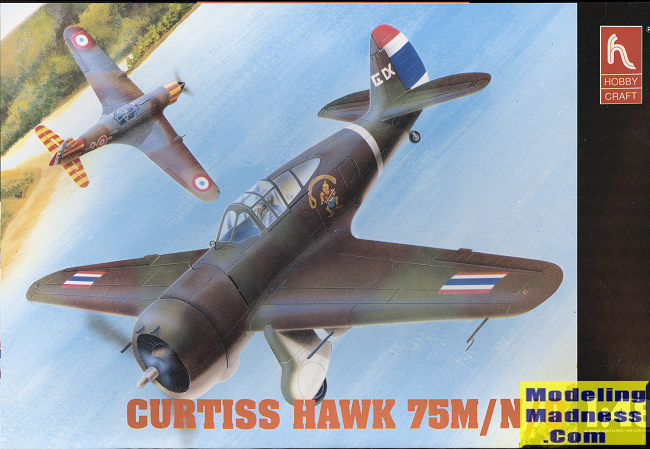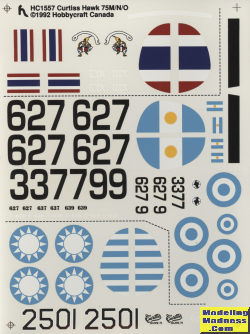
| KIT #: | HC1557 |
| PRICE: | $9.55 from the base exhange in 1993 |
| DECALS: | Four options |
| REVIEWER: | Scott Van Aken |
| NOTES: | 1992 release |

| HISTORY |
The Curtiss P-36 Hawk, also known as the Curtiss Hawk Model 75, is an American-designed and built fighter aircraft of the 1930s and 40s. A contemporary of both the Hawker Hurricane and Messerschmitt Bf 109, it was one of the first of a new generation of combat aircraft—a sleek monoplane design making extensive use of metal in its construction and powered by a powerful radial engine.
Perhaps best known as the predecessor of the Curtiss P-40 Warhawk, the P-36 saw little combat with the United States Army Air Forces during World War II. It was nevertheless the fighter used most extensively and successfully by the French Armee de l'air during the Battle of France. The P-36 was also ordered by the governments of the Netherlands and Norway, but did not arrive in time to see action before both were occupied by Nazi Germany. The type was also manufactured under license in China, for the Republic of China Air Force, as well as in British India, for the Royal Air Force (RAF) and Royal Indian Air Force (RIAF).
Axis and co-belligerent air forces also made significant use of captured P-36s. Following the fall of France and Norway in 1940, several dozen P-36s were seized by Germany and transferred to Finland; these aircraft saw extensive action with the Ilmavoimat (Finnish Air Force) against the Soviet Air Forces. The P-36 was also used by Vichy French air forces in several minor conflicts; in one of these, the Franco-Thai War of 1940–41, P-36s were used by both sides.
From mid-1940, some P-36s en route for France and the Netherlands were diverted to Allied air forces in other parts of the world. The Hawks ordered by the Netherlands were diverted to the Dutch East Indies and later saw action against Japanese forces. French orders were taken up by British Commonwealth air forces, and saw combat with both the South African Air Force (SAAF) against Italian forces in East Africa, and with the RAF over Burma. Within the Commonwealth, the type was usually referred to as the Curtiss Mohawk.
With around 1,000 aircraft built by Curtiss itself, the P-36 was a major commercial success for the company. It also became the basis not only of the P-40, but two other, unsuccessful prototypes: the P-37 and the XP-42.
| THE KIT |
According to Scalemates, this and several other variants were released 'en masse' in 1992. The kits were, from my understanding, tooled by Academy a company that, at the time, was known for fair kits, but nothing spectacular. In fact, some of the P-36 style kits have been reissued by Academy, but not this one nor the Mohawk.
What makes this kit different from the standard P-36/Hawk 75 boxing is that it has fixed landing gear. This requires a new lower wing without the usual gear wells. It also eliminates the 'knuckles' that P-36 and P-40 airframes have to accomodate the retracting landing gear. This is a good thing as these parts are not the best fitting on the other boxings. It also requires new engine and cowling as these planes were powered by the Wright R-1820 and not the P&W R-1835. This means a taller and thinner cowling.
 Interior is
fairly basic, but adequate with some sidewall detail included. The landing gear
spats are also a bit different depending on the markings option you will be
using so keep that in mind from the start. There are also some other optional
parts like a DF 'football' and different quarter windows. You can pose the
canopy open and the kit provides for that. In addition, there are three
different types of exhaust.
Interior is
fairly basic, but adequate with some sidewall detail included. The landing gear
spats are also a bit different depending on the markings option you will be
using so keep that in mind from the start. There are also some other optional
parts like a DF 'football' and different quarter windows. You can pose the
canopy open and the kit provides for that. In addition, there are three
different types of exhaust.
| CONCLUSIONS |
I'm not sure if Academy will reissue this boxing as it is currently difficult to find. The kit is not difficult to build and while not up to modern standards in terms of cockpit detail, will make a very nice addition to your collection if you can locate one.
| REFERENCES |
https://en.wikipedia.org/wiki/Curtiss_P-36_Hawk
September 2020
Copyright ModelingMadness.com. All rights reserved.
If you would like your product reviewed fairly and fairly quickly, please
contact the editor
or see other details in the
Note to
Contributors. Back to the Main Page
Back to the Review
Index Page
Back to the Previews Index Page